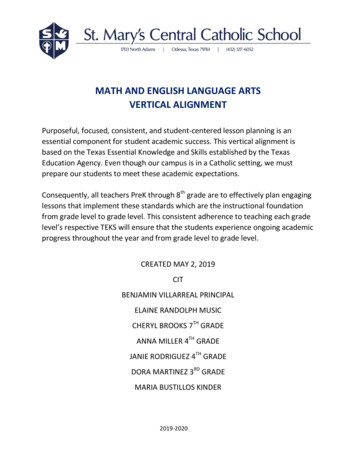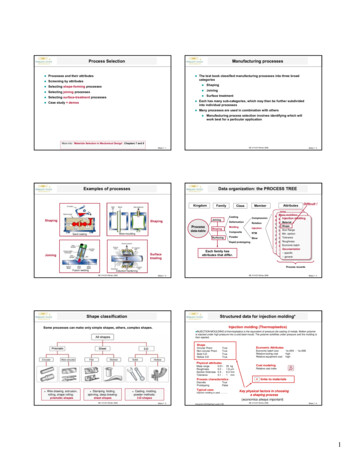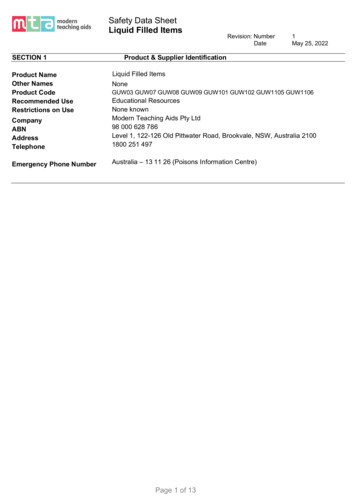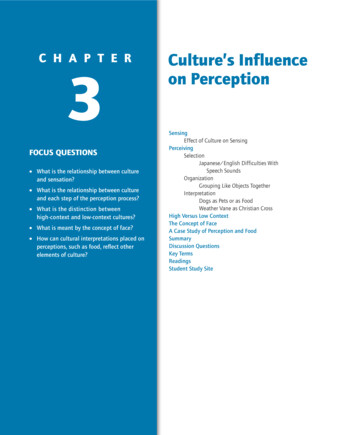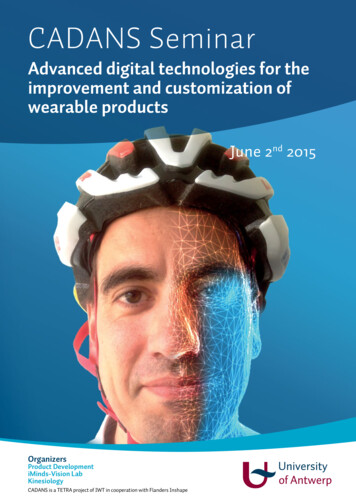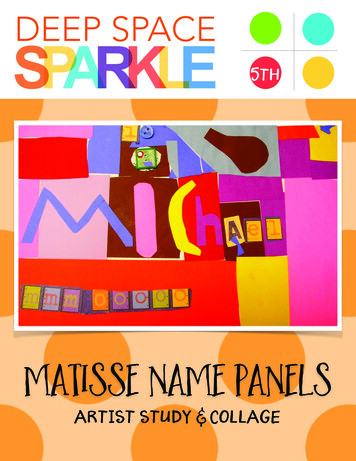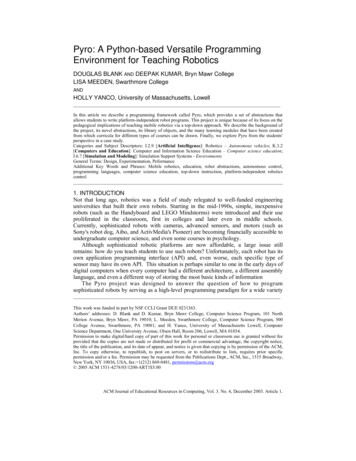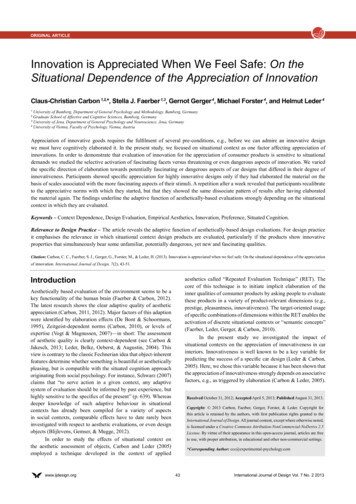
Transcription
How Programming Environment Shapes Perception,Learning and Goals: Logo vs. ScratchColleen M. LewisGraduate School of EducationUniversity of California, BerkeleyBerkeley, CA 947201- 510-388-7215colleenl@berkeley.eduABSTRACTBuilding upon the early work on Logo, a new programmingenvironment Scratch [2] offers much of the same functionality asLogo. However in Scratch the code blocks only lock into place insyntactically valid ways, therefore “bugs” are always semanticerrors and never the result of a typing error or a misremembereddetail of language syntax. Scratch is one of the recently developedvisual programming languages that are thought to make complexelements of flow of control, such as loops and conditionals, morenatural [5]. This study evaluates the pedagogical value of Scratchin comparison to a well researched tool, the Logo programmingenvironment. We hypothesized that in comparison with studentsusing Logo, students using Scratch would:This study compares the attitudinal and learning outcomes ofsixth grade students programming in either Logo or Scratch.Given proposed affordances of the visual programming language,Scratch, I hypothesized that those students learning Scratch woulddemonstrate greater competence in interpreting loops andconditional statements and would have more positive attitudestowards programming. However, differences in performancebetween the two groups appeared only in the greater ability of thestudents that learned Scratch to interpret conditional statements.Contrary to our hypothesis, we found that students that learnedLogo had on average higher confidence in their ability to programand students were no more likely to plan to continue to programafter the course or view the learning of topics as difficult if theylearned Logo or Scratch. Categories and Subject DescriptorsK.3 [Computers and Education]: General General TermsBe more likely to report that programming in general and thelearning of individual constructs was easy.Feel more confident about their competence writingcomputer programs and be more likely to report that theyplan to continue to pursue computer programming.Be better able to trace the flow of control of loops andconditionals.Human factors2. PREVIOUS RESEARCHKeywordsNew languages, such as Scratch, typically build from previouslanguages to offer new functionality and claimed pedagogicaladvantages. This study builds upon a line of research that hasbegun to explicitly test the pedagogical claims of newprogramming tools. In a study designed to see if students learningJava will spontaneously develop competency with flow of controlconstructs in a visual programming language, Alice, theresearchers, Parsons and Haden, found that “students struggled tomake the connection between work in Alice and ‘realprogramming’.”[5]. In an effort to provide fewer syntacticconstraints, visual programming languages may be perceived as“simple” and not related to real programming. However, researchcomparing learning in a more and a less syntactically strictlanguage, Java and Python respectively, attribute the greatersuccess of students in Python to be a result of reduced syntacticcomplexity [3].Scratch, Logo, K-12, Programming1. INTRODUCTIONProgramming has been seen as an opportunity for students todevelop the intellectual resources to tackle challenging problems[4]. However, many of the studies failed to show expectedbenefits and the Logo community did not flourish as hoped [1][3].Many of the challenges faced by students learning to program inLogo can be understood through the limitations of theprogramming environment. For example, before testing a programin Logo, each line of code must adhere to syntactic constraints.This fragile environment may cause students to focus theirattention on the syntax of the code and miss the opportunity tofocus on the semantic meaning.Permission to make digital or hard copies of all or part of this work forpersonal or classroom use is granted without fee provided that copies arenot made or distributed for profit or commercial advantage and that copiesbear this notice and the full citation on the first page. To copy otherwise,or republish, to post on servers or to redistribute to lists, requires priorspecific permission and/or a fee.SIGCSE’10, March 10–13, 2010, Milwaukee, Wisconsin, USA.Copyright 2010 ACM 978-1-60558-885-8/10/03. 10.00.3. METHODOLOGY3.1 SettingParticipants were students enrolled in the course “Making Music,Movies, and Games with Computers”, a summer enrichmentprogram offered through the Academic Talent Development346
Program (ATDP) at the University of California, Berkeley. Thecourse met for a total of 36 hours over 12 days. All courseparticipants had completed fifth grade and were between 10 and12 years old. Students applied to participate in this enrichmentprogram that is designed for academically advanced students.3.5 Data SourcesWritten assessments were given on the second and fifth days ofclass to assess student understanding of concepts and techniquescovered the previous class day. Written surveys were given at theend of the sixth day of instruction and beginning of the seventh togather information regarding the students’ evaluation of theirexperience during class as well as their interests and goals.There were 2 offerings of the course, with the exact same coursedescription. Students indicated in their application a preferencefor the morning or the afternoon offering and were placed in theirpreferred offering on a first-come, first-served basis. Eachoffering of the course was taught by the same instructors, theauthor with the assistance of two teacher aids.4. DATA ANALYSIS4.1 Similarity of Treatment GroupsWhen the students applied to the course, they were not aware ofany difference between the two versions of the course. Basedupon this sampling method, we did not suspect that the twogroups would vary greatly. As a precaution, on the first day weadministered a survey of prior computer experience. Thedifferences responses of the participants in Treatment 1 andTreatment 2 were not statistically significant at the 5% level (z 1.007; p 0.3140) using the Mann-Whitney-Wilcoxon test.Although this does not demonstrate that the two populations areequivalent, we postulate similarity based upon the samplingmethod and the similarity in distribution of responses regardingprior computer experience. To capture the similarity of the twogroups, histograms of their responses to four representativequestions are provided below in Figure 2. Participants inTreatment 1 (Scratch-First) and Treatment 2 (Logo-First) hadsimilar distributions of responses to the following 4-level Likertquestions.3.2 Treatment GroupsEach offering of the course became a treatment group in thisstudy and the two treatments differed based upon which languagethey learned first. Treatment 1 (Scratch-First) learned to programin Scratch1 for 6 days before beginning instruction in Logo.Treatment 2 (Logo-First) learned to program in Logo2 for 6 daysbefore beginning instruction in Scratch. This study focuses onthese first 6 days and addresses the students’ perceptions, learningand goals before beginning their second programming language.3.3 CurriculumStudents in each class worked in pairs to complete worksheetsdesigned by the researcher to introduce programming constructs.The first 6 days of instruction focused on the core programmingconstructs such as conditionals, variables and loops that areshared by both Logo and Scratch. On each of the first 6 days,students worked on worksheets designed to have students in eachclass accomplish equivalent goals. For example, on the third dayof instruction students in each treatment were asked to draw abrick wall. Figure 1 shows the images that were provided on therespective worksheets to demonstrate the goal. Although theimages and content of the worksheets differ, the goals on eachworksheet were the same. I am good at using the computerI find computers frustrating to useI am comfortable using a mouseI am comfortable typing on a computerFigure 1: Demonstration of the goal of drawing a brick wallfor Logo (left) and Scratch (right)A recent multi-national, multi-institution study [6] suggests that itis possible to translate exams between languages while preservingthe level of difficulty. A similar methodology is used in this studyto create assessments and in-class programming tasks ofcomparable difficulty.3.4 ParticipantsIn Treatment 1 (Scratch-First) there were 16 males and 10females for a total of 26 students. In Treatment 2 (Logo-First)there were 17 males and 7 females for a total of 24 students.1Students used version 1.4 of Scratch (http://scratch.mit.edu).2The version of Logo used was developed by Guy Haas(http://www.bfoit.org/itp/install.html).Figure 2: Student responses to 4-level Likert questionsregarding prior computer experience347
had a much more difficult time learning AND. Figure 4 shows thedistribution of responses to four of the Likert questions regardingdifficulty of learning. The histograms show the similar responsesregarding variables and repeat to contrast the difference indistribution regarding the difficulty of conditionals.4.2 Student Report of DifficultyTo investigate the hypothesis that students in Treatment 1(Scratch-First) would be more likely to judge programming andthe learning of individual constructs to be easy, all studentsresponded to questions regarding their experience of the difficultyof learning various programming commands and constructs. Thequestions were given on the 7th day of instruction, beforeintroducing students to a second language. There were 8 questionscovering the following constructs: repeat, variable creation,if, and, forward/move, set x and y coordinate, set pen color,and set heading. The students responded to a 4-level Likertquestion in the form of “It was hard to learn how to use[Programming Construct]”. A response of “Agree” was coded as a4 to indicate that the programming command was hard to learnwhile “Agree somewhat”, “Disagree somewhat” and “Disagree”were coded 3, 2 and 1 respectively. The total of the coded scoresfor the 8 questions were added together to create a rating ofperceived difficulty for each student.Figure 3 below shows the students’ rating of difficulty bytreatment group. Students from Treatment 1 (Scratch-First) had arange of scores between 32 and 46 with a mean rating of 37.62out of 64 and a standard deviation of 3.43. Students fromTreatment 2 (Logo-First) had a similar range from 32 to 45 but aslightly higher mean of 38.35 and a standard deviation of 3.70.The difference between the means of the two groups was less than1 out of 64 and was not significant at the 5% level (z 0.716,p 0.4743).Figure 4: Student responses to 4-level Likert questionsregarding the difficulty of learning4.3 Confidence of Treatment GroupsTo investigate the hypothesis that students in Treatment 1(Scratch-First) will feel more confident about their competencewriting computer programs and be more likely to report that theyplan to continue to pursue computer programming the studentswere asked to respond to the following questions using a 4-levelLikert response: Figure 3: Student cumulative rating of difficulty ofprogramming commandsWriting computer programs is easy.I am good at writing computer programsI plan to continue programming after the class is over.I want to take another computer programming course.The results, shown in Figure 5, were analyzed using a MannWhitney-Wilcoxon test. Despite the expectation that Scratchmakes programming easier, there was no statistical significancebetween the treatment groups on their response to the question:“Writing computer programs is easy” (z -1.560; p 0.1189).However in response to the question “I am good at writingcomputer programs” it was Treatment 2 (Logo-First) thatanswered more positively and the differences between thetreatment groups was statistically significant at the 5% level (z 2.016, p 0.0438). This provides evidence that could prove thecounter-hypothesis, that students in Logo will judge theircompetence at programming higher. It is possible that like theresults from [5], the students learning Scratch did not recognizeScratch as “writing computer programs”. However, otherThe unexpected result of no difference between perceiveddifficulties motivated further investigation. Through an analysisof individual questions, we found that while most students in eachtreatment group disagreed with the statements “It was hard tolearn how to use variables” and “It was hard to learn how to userepeat” the groups diverged when asked about learningconditionals. Two questions requested information about theprocess of learning conditionals: “It was hard to learn how to useIF” and “It was hard to learn how to use AND”. There was astatistically significant response, using a Mann-WhitneyWilcoxon test, between the two groups when responding to “Itwas hard to learn how to use AND” (z 2.423; p 0.0154). Theseresults match the instructors’ perception that students using Logo348
references to “writing computer programs” in the coursepresumably serve to cue the student that they are engaged in“writing computer programs”. For example, in the same survey,the students responded to the questions (emphasis added)“Writing computer programs is easy”, “It is possible to knowwhat a computer program will do before you run it”, “When I runa computer program twice in a row it will do the same thing”, and“What is the most frustrating thing about writing computerprograms?”4.4 Student Assessments4.4.1.1 Student Interpretation of LoopsAt the beginning of the 2nd day, after 3 hours of instruction,students were given an assessment where they were asked todescribe the results of repeat statements. A representativequestion is shown in Figure 7. This example shows a nestedrepeat statement translated into both Logo and Scratch.Students in each treatment group saw the corresponding repeatstatement and were asked to write answers to the followingquestions: How many beats/seconds will this example take to run?How many times will the example play the note 60?repeat 5 [playnote 67 1 repeat 10 [playnote 60 1]]Figure 5: Student responses to 4-level Likert questionsregarding competence programmingAn alternate explanation is that even after 18 hours of instructionstudents in Treatment 1 (Scratch-First) had not used everycommand appearing in the Scratch menus, which might haveeroded their confidence in their abilities. In contrast studentsusing Logo may have been under the impression that they hadlearned everything that Logo had to offer. Future research willseek to isolate the effects of these different factors.Figure 7: Example question from assessment of ability tointerpret loopsWe expected that the Scratch question would be easier for thestudents to answer because of the additional context regarding themeaning of the commands. For example, Figure 8 shows acomparison of the Logo and Scratch syntax to play a note.Whereas the Scratch command can be read like a sentence “playnote 67 for 1 beats”, in the Logo example there are no cues thatdifferentiate the note to be played from the duration. Despite thisapparent complexity, no students answered with a number over 55on any questions, which might have indicated a student confusingthe note number as the duration for the note. As opposed toconfusion regarding the play note command, it appears thatstudent difficulty was associated with the behavior of therepeat.As shown in Figure 6, regardless of initial programminglanguage, the majority of students agreed or agreed somewhatwith the statements: I plan to continue to program after the class is over.I want to take another computer programming course.This suggests that although we hypothesized that studentsexposed to Scratch would be more likely to plan to continue toprogram after the course, students indicate a similar level ofintention to continue programming or take additional computerprogramming courses regardless of what languages they haveseen.playnote 67 1Figure 8: The play note command in Scratch and LogoThe performance difference between the two groups was notstatistically significant (z -0.945; p 0.3448). Students fromTreatment 1 (Scratch-First) had a mean of 3.0 and a standarddeviation of 2.6. Students from Treatment 2 (Logo-First) had amean score of 2.4 and a standard deviation of 2.7.This assessmentdoes not confirm our hypothesis that students using Scratch wouldoutperform students using Logo on their ability to interpret repeatstatements.4.4.1.2 Student Interpretation of ConditionalsFigure 6: Student responses to 4-level Likert questionsregarding their future plans for computer programmingAt the beginning of the 5th day, after 12 hours of instruction,students were given an assessment of their ability to interpret the349
result of conditional statements. On the previous day, both groupsof students had made a simplified paint program that involvedsetting the pen color depending upon the location of the mouse.The assessment asked them to consider similar examples of codeand predict the final pen color or in some cases say what noteswould be played. The most complicated example includedinterpreting the result of the code shown in Figure 9 for a series ofx and y locations for the mouse.5. CONCLUSION AND FUTURE WORKWhile the Logo environment appeared capable of supportingstudent development of confidence, interest in computerprogramming, and understanding of the loop construct, theScratch environment provided a relative improvement in learningoutcomes for students learning the construct of conditionals.Scratch offers a number of affordances that would suggest that itshould be easier to learn and interpret. Given these affordances, itis surprising that the students learning Logo and Scratchperformed similarly when interpreting loops. For example, inLogo students have only a textual representation and during thelearning process would presumably be distracted by low-leveldetails such as syntax. However, perhaps this low-level focusallows students to focus on some important low-level details, suchas the role of every command in a larger program. It may be thatthis low-level focus allowed students learning Logo tocompensate for the lack of a visual representation.setpencolor 1if greater? mousey[setpencolor 2]0if less?mousey[setpencolor 3]0if greater? mousex 200[setpencolor 4]There has been a significant amount of research done on studentexperiences in Logo however, only through a comparison with adifferent programming environment, such as Scratch, can webegin to isolate the features of student experience impacted by thecontent of programming and those impacted by the programmingenvironment.if greater? mousex 100[setpencolor 5]if less?mousex -100[setpencolor 6]6. ACKNOWLEDGMENTSI want to thank the study participants, Andrea diSessa, MichaelClancy, Randi Engle, Steven Kisely, George Wang and othermembers of the Patterns, UC-WISE and Video research groups atthe University of California, Berkeley. I want to thank the Scratchteam at MIT and Guy Haas for his development and support ofJLogo. This work was partially supported by a grant from theSpencer Foundation (grant number 200500036) to Andrea A.diSessa, PI.Figure 9: Question from assessment of ability to interpretconditionals expressionsFigure 10 below shows a box plot of the cumulative scores on theassessment of student ability to interpret conditional expressions.The mean score for students in Treatment 1 (Scratch-First) was8.16 out of 13, while the mean score for Treatment 2 (Logo-First)was only 5.68. A Mann-Whitney-Wilcoxon test was used tocompare the performance of each group and the higherperformance of students in Treatment 1 (Scratch-First) wasstatistically significant at the 1% level (z -2.528, p 0.0115).7. REFERENCES[1] diSessa, A. (2000). Changing Minds: Computers, Learning,and Literacy. MIT Press:Cambridge, MA.[2] Maloney, J., Peppler, K., Kafai, Y. B., Resnick, M., & Rusk,N. (2008). Programming by Choice: Urban Youth LearningProgramming with Scratch. ACM Special Interest Group onComputer Science Education., Portland: ACM.[3] Mannila, L., Peltomaki, M., & Salakoski, T. (2006). WhatAbout a Simple Language? Analyzing the Difficulties inLearning to Program. Computer Science Education, 16(3),211-227.[4] Papert, S. (1980). Mindstorms: Children, Computers, andPowerful Ideas. New York: Basic Books, Inc.[5] Parsons, D., & Haden, P. (2007). Programming Osmosis:Knowledge Transfer from Imperative to VisualProgramming Environments. In S. Mann & N. Bridgeman(Eds.), Procedings of The Twentieth Annual NACCQConference (pp. 209-215). Hamilton, New Zealand.[6] Whalley, J. (2006). CSEd Research Instrument Design: TheLocalisation Problem. In S. Mann & N. Bridgeman (Eds.),Proceedings of The Nineteenth Annual NACCQ Conference(pp. 307-312). Wellington, New Zealand.Figure 10: Box plot of student performance on assessment ofconditionals350
they learned first. Treatment 1 (Scratch-First) learned to program in Scratch1 for 6 days before beginning instruction in Logo. Treatment 2 (Logo-First) learned to program in Logo2 for 6 days before beginning instruction in Scratch. This study focuses on these first
